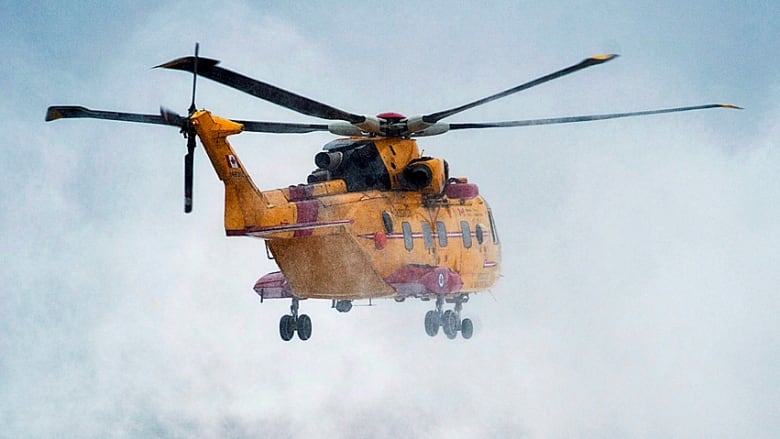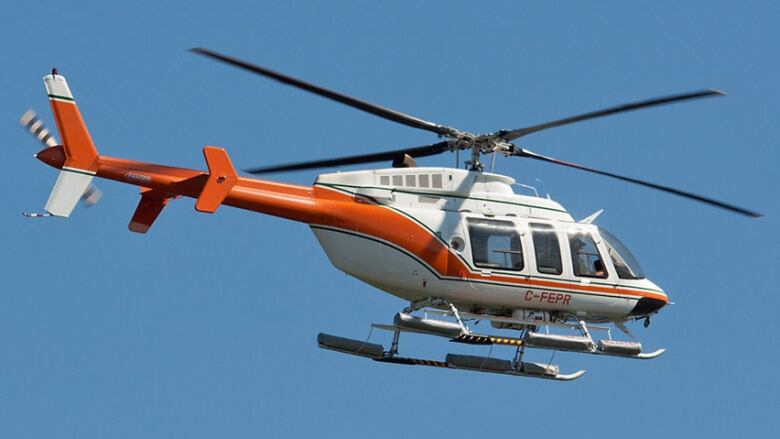Repeated N.L. calls for military help with medevacs sparked search and rescue concerns
‘On occasion, these patient transfer cases cause us to go red,’ top JRCC official said in 2017 email

Top military officials discussed last year how continual requests for help with provincial medical calls could impact their primary mission to provide vital search and rescue services in the waters off Newfoundland and Labrador.
"On occasion, these patient transfer cases cause us to go red resulting in a lapse of SAR coverage," Maj. Rhonda Stevens, then officer-in-charge of Joint Rescue Coordination Centre (JRCC) Halifax, said in an internal Jan. 12, 2017 email obtained by CBC News through access to information.
On occasion, these patient transfer cases cause us to go red resulting in a lapse of SAR coverage.- Maj. Rhonda Stevens in Jan. 12, 2017 email
"When the Cormorant has to [remain overnight] in Goose Bay due to crew day or weather and it is the only serviceable aircraft in Gander, we are scrambling to ensure backup options are in place to respond to SAR cases."
Last year, the Newfoundland and Labrador government downplayed any concerns about the effectiveness of its own medical helicopter service, with officials stressing that they could always call on those federal search and rescue choppers for help.
But around the same time, military officials were discussing why they were being called so often, the potential impacts of providing that service, how much it cost, and who should pay.
At this point, nothing has changed and the situation remains status quo, Lt.-Col. Kevin Toone told CBC News.

"Right now, it's not a problem," said Toone, who is senior advisor to the commander of Canadian Joint Operations Command for search and rescue.
"We do a risk analysis prior to launching any aircraft. We always make sure that when the province is requesting it, that we are a last resort and that they have gone through all the proper process, to find out if they can use their own resources, or if they can contract resources."
Issue of 'operational risk' discussed
In 2016, provincial health officials called the Department of National Defence for help in handling more than half of all helicopter medevacs that year — nearly one per week.
According to military statistics obtained by CBC News, those search and rescue helicopters were away from their primary job for an average of four flying hours per call. That doesn't include time on the ground.
If we're off doing something other than our primary job, which is air/sea rescue ... that could interfere with our timely response to that primary job.- Lt.-Col. Kevin Toone
Toone was part of some of those email exchanges a year ago discussing the issue of "operational risk" in repeatedly helping with provincial medevacs.
"If we're off doing something other than our primary job, which is air/sea rescue, if we're off doing something else, then that could interfere with our timely response to that primary job," Toone explained in an interview.
"Once you have that patient onboard, you're not going to land somewhere to offload them if it's not an appropriate facility to leave them at. So that could impact a timely response to an aeronautical or maritime incident."
JRCC Halifax covers vast geographic area
JRCC Halifax is responsible for 4.7 million square kilometres that includes all four Atlantic provinces, the eastern half of Quebec, the southern half of Baffin Island in Nunavut, and the northwestern quadrant of the Atlantic Ocean.
The rescue coordination centre oversees CH-149 Cormorant helicopters based at 103 Search and Rescue Squadron at 9 Wing Gander.
Their primary focus is air and sea rescues.
Medevacs and patient transfers on land are the responsibility of the province.

But the province's choppers can't always do the job, the DND documents note, because of weather or other restrictions.
"With regard to helicopters, there are five on contract with the province of N.L. from Universal Helicopters but they are day VFR [visual flight rules] only which creates limitations in remote areas that the [fixed-wing] aircraft cannot access and at night," Maj. Rhonda Stevens noted in another email.
"These helicopters also service other provincial departments as well so are not always available."
In an emailed statement to CBC News, the Newfoundland and Labrador Department of Health said it would not be able to speak to search and rescue operations, noting that it is a federal mandate.
'Disproportionate number' of N.L. requests
The number of requests for help in Newfoundland and Labrador were much higher in 2016 than the rest of the area covered by JRCC Halifax.
Lt-Col. Jay Nelles of 1 Canadian Air Division headquarters called it a "disproportionate number," in a Jan. 13, 2017 email.
In Newfoundland and Labrador that year, there were 50 requests with services rendered 49 times.
In the other provinces and territories — Quebec, Prince Edward Island, New Brunswick, Nova Scotia, and Nunavaut — there were just 11 combined.

Nelles noted that this rate of request had not caused any "strain on resources," but creates an "exposure to operational risk" if a search and rescue call comes in at the same time as a medevac request.
According to internal military emails, the then-top military official in the Atlantic region, Rear Adm. John Newton, planned to write Premier Dwight Ball's chief of staff to provide him with those numbers.
This is how Maj. Rhonda Stevens of JRCC described Newton's "intent" in providing those stats to the premier's office, in a "friendly and understanding" tone: "These flights are military and not [coast guard]. These are beyond our mandate, are not SAR, and are done in so far as we can undertake them considering SAR liabilities that might exist."
That letter does not appear to have ever been sent to the premier's office. It was not among the records released to CBC News.
Flights cost millions
In 2016, the total cost to the feds of covering Newfoundland and Labrador medevacs was at least $7 million, according to military records obtained by CBC News.
Ottawa didn't send the province a bill for doing any of that work — but considered doing so for "routine" patient transfers.
However, nothing has changed and Ottawa continues to foot the bill, according to Toone.
"No cost recovery is happening at this time," he told CBC News.
He said the purpose of the email discussion a year ago was simply to flag an "unusual" statistic, and ensure the chain of command was aware, just in case there is a potential increase in risk in the future.
"With the night time and the weather, and then the unusual circumstances in Newfoundland, we do get a fair amount of calls," Toone added.
"When we send an aircraft to do a humanitarian mission, it's because we do not expect it to interfere with anything from our primary mandate. Of course, that can change with a phone call."
In 2017, those numbers dropped slightly, to 35 humanitarian medevacs for the province, almost all of them involving Cormorants.
But they may be back on the rise — there were six Cormorant medevacs in January alone, a pace that would double the number from last year.
Obtained through access to information
Using access to information, CBC News obtained more than 100 pages of internal Department of National Defence emails and reports about the use of search and rescue helicopters to do medevac calls that are the responsibility of the province.
It took 10 months and a complaint to the federal information commissioner to get those records.


